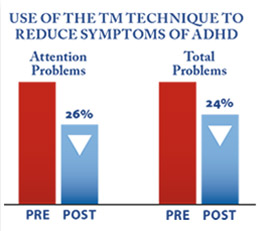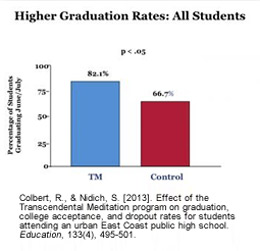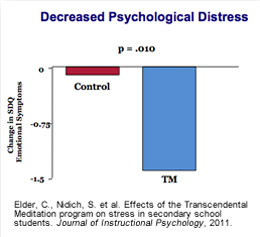Fifty years ago, the U.S. educational system scored the highest in high school graduation rates among 27 industrialized nations. Today, we rank 22nd, with dropout rates of 27 percent. And for underserved African-American and Hispanic students in urban schools across the nation, the dropout rates are much, much worse—close to 40 percent.
As you would expect, the rest of the numbers don’t look good either. According to the National Assessment of Educational Progress, which functions as the nation’s report card, the United States is flunking. Two out of three eighth-graders can’t read proficiently. Nearly two-thirds of eighth-graders scored below the proficient level in math.
Introducing Quiet Time
Yet there are bright lights in the educational landscape. Some of our most troubled schools have implemented a program called Quiet Time, which allows students to be quiet, read, or practice meditation for ten minutes twice a day on school time. The Transcendental Meditation technique is one of the options for Quiet Time.
 Recent research shows that Quiet Time is having a positive impact, with one urban school reporting an increase in attendance to 98.6 percent, an 86 percent drop in suspension, and a 42-point gain in academic performance on state tests.
Recent research shows that Quiet Time is having a positive impact, with one urban school reporting an increase in attendance to 98.6 percent, an 86 percent drop in suspension, and a 42-point gain in academic performance on state tests.
Research on the Quiet Time program in other troubled urban schools reveals equally impressive results, with reduced symptoms of ADHD and other learning disorders, 40 percent reduction in psychological distress, and 65 percent decrease in violent conflict over two years. And yes—one study showed a 15 percent improvement in graduation rates.
But how does it work?
A Surge Protector against Stress
“All of us have kids you try to teach, but their heads are down on the desk,” says the now retired superintendent of a school district that was one of the first to bring Quiet Time into its schools. “They’re out of it while you’re trying to teach. Why? Because of their lives. Because of stress.”
 According to an American Psychological Association survey, 27 percent of adolescents report feeling extremely anxious during the school year. One in three children is obese and 11 percent have been diagnosed with ADHD. All of these problems are related to stress—and all can hamper a child’s learning ability.
According to an American Psychological Association survey, 27 percent of adolescents report feeling extremely anxious during the school year. One in three children is obese and 11 percent have been diagnosed with ADHD. All of these problems are related to stress—and all can hamper a child’s learning ability.
A new study published in the Journal of Instructional Psychology found that TM significantly decreased psychological distress in public school students. The study, conducted with at-risk, minority, secondary-school students, showed a 36 percent reduction in overall psychological distress. Significant decreases were also found in trait anxiety and depressive symptoms.
Increased Academic Achievement
The journal Education recently reported that students from an urban middle school saw their academic achievement improve when they experienced more inner quietness and less stress after the introduction of the Quiet Time program with the TM option.
“These initial research studies, showing the benefits of the Quiet Time program on reducing stress and raising academic achievement, hold promise for public education,” says Sanford Nidich, Ed.D., professor of education and lead investigator of both studies. “The findings suggest that this is a practical educational program which can help low-performing minority students begin to close the achievement gap.”
Higher Graduation Rates
Another pioneering study focused on graduation rates in an East Coast, urban high school. Graduation rates are the litmus test of educational success—and recent data show that only 69 percent of students graduate from our nation’s schools.
 “Urban schools on the whole tend to suffer from a range of factors that contribute to poor student academic performance and low graduation rates,” says lead author Robert D. Colbert, Ph.D., associate professor at the University of Connecticut.
“Urban schools on the whole tend to suffer from a range of factors that contribute to poor student academic performance and low graduation rates,” says lead author Robert D. Colbert, Ph.D., associate professor at the University of Connecticut.
Results showed a 15 percent higher graduation rate for a group that was practicing the TM technique as compared to non-meditating controls. The largest effect was found in the most academically challenged students, with a 25 percent increase in graduation rates.
Findings also showed that meditating students were less apt to drop out from school or enter prison, and were more likely to be accepted to post-secondary institutions.
“In just six months, the brain functioning of the meditating students had moved from being solidly within clinical ADHD symptoms to just within normal brain functioning.” — Dr. Fred Travis
Better Brain Power
Researchers now realize that stress also affects concentration, focus, and other functions of the developing brain. They understand that problems such as ADHD, the inability to control attention, are caused by underdevelopment or underutilization of the prefrontal cortex, which shuts down under stress. By addressing that stress, students can bring about a marked and highly visible increase in the coherent functioning of their brains.
In a landmark study published in Current Issues in Education, researchers Sarina Grosswald, William Stixrud, and Fred Travis looked at brain functioning of children with ADHD who practiced the TM technique, as compared to controls.
“In just six months, the brain functioning of the meditating students had moved from being solidly within clinical ADHD symptoms to just within normal brain functioning,” says Dr. Travis, Director of the Center for Brain, Consciousness, and Cognition.
“What that means in practical terms is that they were able to start self-regulating both physical and mental impulses,” he says. “So, for example, they were able to remember to raise their hand before speaking.”
Brainwave Coherence
Based on these initial findings, Dr. Travis and his colleagues decided to look at brainwave coherence, as measured by EEG, to find out if the practice of TM could help children with ADHD develop a more integrated brain functioning.
 “In this random-assignment pilot study of children with ADHD aged eleven to fourteen, we saw significant increases in coherence in all parts of the brain in four frequency bands,” says Dr. Travis. “This means the brain is ceasing to function as isolated modules and is beginning to function more as a whole.”
“In this random-assignment pilot study of children with ADHD aged eleven to fourteen, we saw significant increases in coherence in all parts of the brain in four frequency bands,” says Dr. Travis. “This means the brain is ceasing to function as isolated modules and is beginning to function more as a whole.”
Dr. Travis explains that integrated brain functioning results in improved focus on schoolwork, organizational abilities, ability to work independently, level of happiness, and quality of sleep. “The TM group also improved in something called ‘letter fluency,’ which measures the ability of the frontal lobes to generate many new ideas, to be more creative,” he says.
“In today’s world of fear and uncertainty, every child should have two short class periods a day to dive deep within themselves and experience the field of silence and inner happiness.” —David Lynch
Change Begins Within
To help underserved kids learn, acclaimed movie director David Lynch established the David Lynch Foundation for Consciousness-Based Education and World Peace in 2005. He is passionate about helping kids reduce stress, succeed in school, and follow their dreams.
“In today’s world of fear and uncertainty, every child should have two short class periods a day to dive deep within themselves and experience the field of silence and inner happiness—the enormous reservoir of energy and intelligence that is deep within all of us,” he says. “This is the way to save the coming generation.”


Comments
TM in the News
HuffPost Reports: TM Comes to Brooklyn School
In case you haven't heard, Transcendental Meditation is on the minds of many students, teachers, and administrators. Jaweed Kaleem took an in-depth look.
Better Health
Native Americans Return to the Sacred | 6:41
“The way I experience meditating is that it calms you, helps your brain work, and helps it grow.” —Tribal student
TM in the News
Mantras before Math Class | 2:30
Today, it seems that the David Lynch Foundation can't keep up with the demand for TM and the Quiet Time program in schools across the country. Jennie Rothenberg Gritz, writing for The Atlantic, reports.